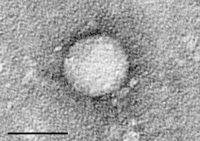
Photo from wikipedia
Objectives To define the seroprevalence of SARS-CoV-2 in blood donors (referred to the first lockdown area (Lodi Red-Zone) of the Lombardy region and in a contiguous area that was not… Click to show full abstract
Objectives To define the seroprevalence of SARS-CoV-2 in blood donors (referred to the first lockdown area (Lodi Red-Zone) of the Lombardy region and in a contiguous area that was not included in the first lockdown ii) to define the agreement of commercial serological assay with a reference microneutralization assay; iii) to evaluate the persistence of SARS-CoV-2 neutralising antibodies in a blood donors cohort. Methods Blood donors referred to the first lockdown area in Lombardy Region and the neighbouring area were analysed for SARS-CoV-2 IgG specific antibodies during the period 18March-24June. Serum samples were analysed using both chemioluminescent assay (Liason SARS-CoV-2 S1/S2 IgG, Diasorin) for the quantitative characterization of SARS-CoV-2 anti-S1 and anti-S2 IgG antibodies and neutralising antibodies (NT-Abs) assay. Results In the period 18 Mach-24 June, 1922 BD were tested for the presence of SARS-CoV2 IgG showing a prevalence of 378/1922 (19.7%). A subgroup of 1139 BD was tested in parallel with SARS-CoV2 IgG assay and a microneutralization assay showing a prevalence of 22.2 and 21.6%, respectively. SARS-CoV2 IgG quantification was correlated with NT-Abs titres. In 78.2% subjects NT-Abs titre was maintained, while in 15.8% decreased of one four-fold dilution and in 6.0% increased of one four-fold dilution. Conclusions The duration of immunity of SARS-CoV-2 is crucial for the course of pandemic and for this reason monitoring of NT Abs is important. Despite a stable NT titer was observed in the majority of blood donors, our findings need to be validated in a long-time period of follow-up.
Journal Title: Clinical Microbiology and Infection
Year Published: 2021
Link to full text (if available)
Share on Social Media: Sign Up to like & get
recommendations!